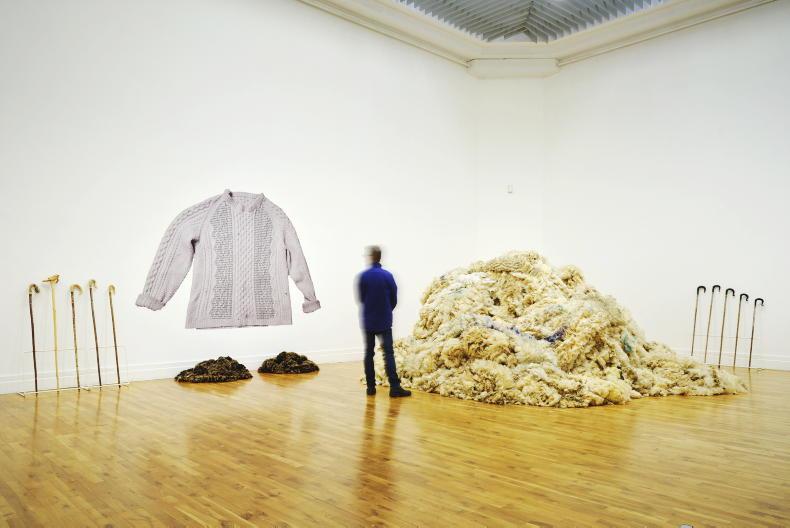I live in Duncormick, Co Wexford. It’s near Kilmore Quay. I’m an artist, a lecturer and a sheep farmer.
“My granny is my guru,” was always my motto. She wrote a column in the Irish Farmers Journal from 1953-1967 called Undercurrents.
Her name was Maureen Barry, but she wrote under the pseudonym of Anne Redmond, because it was about her day-to-day life on the farm. All her children had nicknames; my dad Mícheál was called the QF (the qualified farmer).
I was always interested in art. I guess it came from my grandmother. She used to read me Finnegans Wake by Joyce and go: “Would you listen to that!”

I was into fashion and went to art college with the idea that I wanted to be a fashion designer. You try a bit of everything in the first year, from glassblowing to print making, fine art and more. I just gravitated towards sculpture in the end and that’s what I focused on.
I hadn’t much interest in the farm growing up. I just wanted to get away from Ireland. I lived in Belgium for 16 years and I came back in 2009. If you said to me then I would have sheep by 2011, I wouldn’t have believed you.
I don’t really know how it happened. Maybe there was some kind of sheep whispering in the air in Wexford.
Representing farming
I have a pedigree flock of Lleyn sheep. My dad had a tillage farm, so I had no contact with sheep or any livestock. I learned it all from scratch.
Suddenly I was in at the deep end in farming. I had had quite a successful career in art. I had been doing shows in Europe and that. I kept saying to myself: “How in the hell am I going to manage this now?” I’m lecturing, I’m an artist and I’ve got all these sheep.
My work slowly started to centre around farming, ecology and feminism. I realised I really was in a man’s world; I was going to the pedigree sales and the livestock shows, there weren’t many women around, although I feel that’s slowly changing. I got involved in the Lleyn Club and became the secretary – I was the only woman.
I’m only farming 30 acres, but still, I’d be wondering how my dad put me through college with the small returns from farming?
Recently, I was one of seven women with a farming background that got invited to take part in an exhibition in the Royal Hibernian Academy of Arts (RHA) Gallery in Dublin. It’s called A Growing Enquiry – Art and Agriculture, reconciling values.
In this show all of my work revolves around commerce in one way or another.

It’s a small-scale farm and I cut back even more over the last few years. I had 65 pedigree Lleyn ewes, which was nuts. With all the extra work involved in that, I’ve cut back to about 25 this year and keep the Lleyn hoggets as breeding ewes for sale the following year.
I’m only farming 30 acres, but still, I’d be wondering how my dad put me through college with the small returns from farming?
I’ve noticed that a lot of the people, especially in pedigree breeding, have second jobs. So I wanted to underline in my work for the exhibition how difficult it is in farming to make a living.
My work in the last 10 years really moved towards performance art. These are the first physical objects I’ve made in a while. The work for the exhibition has three elements – wool, wood and sound.
I interviewed the Rathnure businessman and wool merchant John Conran. I choose a part of the interview in which he converted old wool prices from shillings into punts and euros.
Wool is worth roughly 20c/kg now. He said it was worth the equivalent of €2.66/kg in 1945. So it was worth roughly 13 times more.
There’s a big vinyl image of an Aran jumper on the wall with the interview printed on it. It reflects on the contradictions of ecology versus capitalism.
By the end of the film I will have made my decision. I don’t want to give up farming and I think every farmer will relate to that.
I also dumped my wool for the last two years in a big pile in the gallery; the title of the work is Stockpile 2021/22 to underline the worthlessness of this beautiful, ecological and versatile product.
It’s important to me that anybody can understand my work. I think city people can relate to it in a different way than farmers.
Film
Right now the filmmaker Cara Holmes is making a documentary on my farm and my artwork. The main drive for the story of the film is: will I keep doing it or not? It is so hard to manage all the different elements of my life.
Between the sheep, the art and lecturing in sculpture at Carlow IT Wexford Campus School of Art and Design, I’m always firefighting to keep it all on the road.
By the end of the film I will have made my decision. I don’t want to give up farming and I think every farmer will relate to that.
I feel that making my art about farming has been cathartic for me in a way. It’s like studying your childhood through a different lens.
